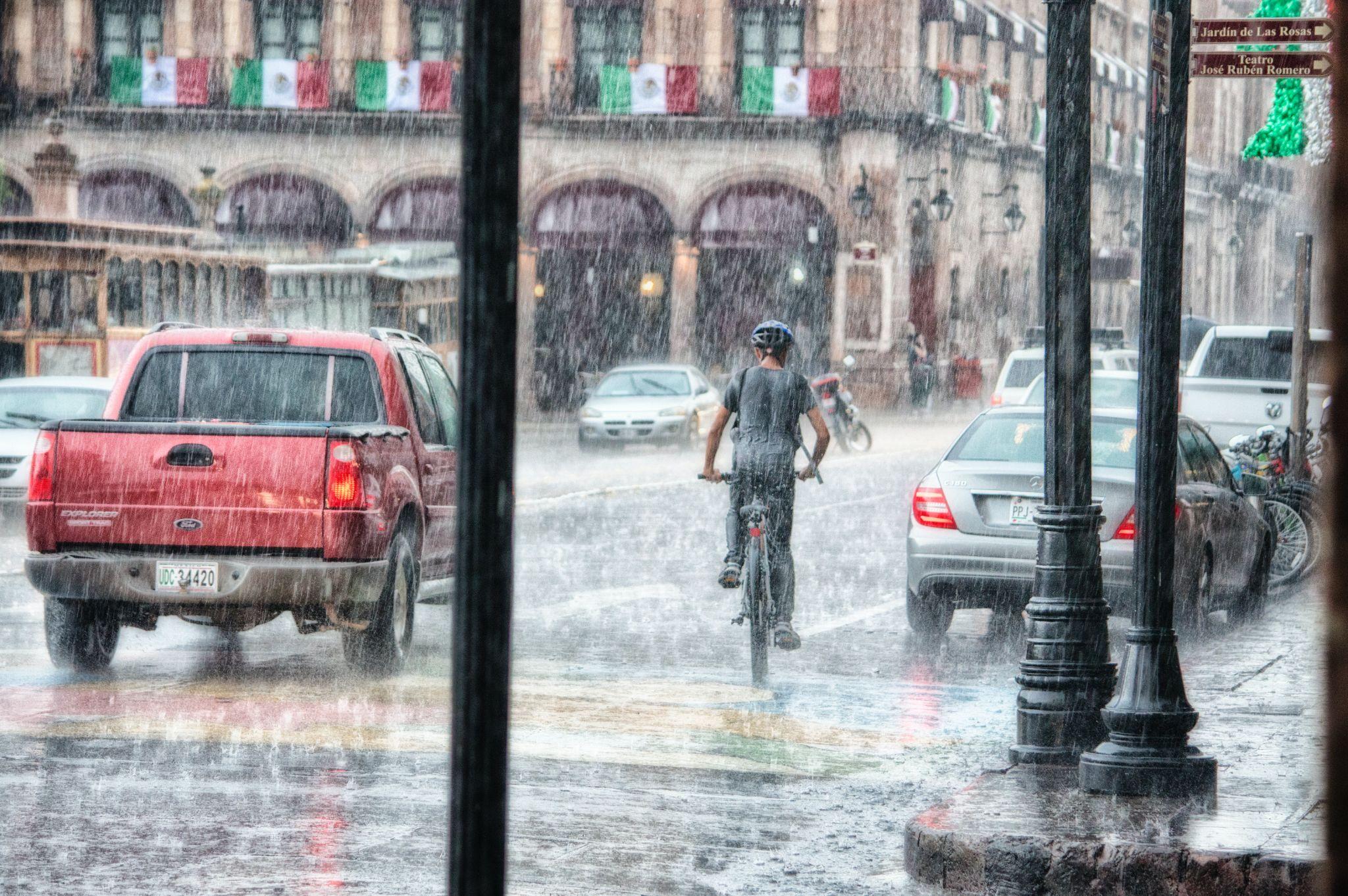50 Capítulo 5: Sección 4: Las acciones en progreso
Section Goal
In this section, students will learn to express ongoing activities or events that are currently happening.
Actividad 20. ¿Qué tiempo hace hoy en tu ciudad?
Instrucciones: Describe el tiempo en tu ciudad ahora.
Paso 1: Mira afuera por la ventana y responde a las siguientes preguntas:
Modelo: ¿Está lloviendo ahora? Sí, está lloviendo. / No, no está lloviendo.
¿Está lloviendo ahora?

¿Está nevando ahora?

¿Está granizando ahora?

Paso 2: Investiga en línea (online) sobre el tiempo (the weather) hoy en la ciudad de Bogotá, Colombia, y responde a las preguntas:
- ¿Está lloviendo en Bogotá hoy?
- ¿Está nevando en Bogotá hoy?
- ¿Está granizando en Bogotá hoy?
Paso 3: Compara las siguientes descripciones del tiempo y reflexiona.
¿Qué diferencias ves en las oraciones? ¿Qué crees que significan esas diferencias?
| A | B |
| En la primavera, llueve muchísimo en mi ciudad. | Hoy está lloviendo en mi ciudad. |
| En el verano, hace muchísimo calor. | Ahora está haciendo mucho calor. |
| En invierno nieva en mi ciudad. | Hoy está nevando. |
Vocabulario
Palabras y frases de tiempo
- Ahora – Now
- En este momento – At this moment
- Actualmente – Currently
Gramática
In the previous activities, you referred to weather conditions that are ongoing, happening as we speak. To talk about activities that are currently happening, we use the present progressive tense, “el presente progresivo”.
El progresivo del presente / el presente progresivo

The verb estar
|
Subject pronoun (singular) |
Verb conjugation |
Subject pronoun (plural) |
Verb conjugation |
|
Yo |
estoy |
Nosotros/Nosotras |
estamos |
|
Tú |
estás |
Vosotros/Vosotras |
estáis |
|
Él/Ella/Elle |
está |
Ellos/Ellas/Elles |
están |
|
Usted |
está |
Ustedes |
están |
Forming the present participle
Sentences in the present progressive require the verb estar + a present participle (-ing ending in English).
If the ongoing activity is a verb ending with -ar, take off the ending -ar and add -ando.
- Nevar = nevando
- Estudiar = estudiando
- Esquiar = esquiando
- Cocinar = cocinando
Ejemplos:
- Está nevando.
- Yo estoy estudiando.
- Pablo está esquiando.
- Mis padres están cocinando.
If the ongoing activity is a verb ending with -er or -ir, take off the ending and add -iendo.
- Comer = comiendo
- Llover= lloviendo
- Salir = saliendo
- Hacer = haciendo
Ejemplos:
- Yo estoy comiendo.
- Está lloviendo.
- Nosotros estamos saliendo para el teatro ahora.
- Mis padres están haciendo la comida.
For -er and -ir verbs that have a stem that ends in a vowel, change the -i in “-iendo” to a ‘y’ (-yendo) to avoid having three vowels in a row.
- Construir = construyendo
- Leer = leyendo
Ejemplos:
- Yo estoy leyendo un libro interesantísimo.
- Mis padres están construyendo una casa en la playa.
Some -ir verbs undergo a stem-change, use an e-to-i or o-to-u stem change.
Where the e in the stem of these verbs changes to i:
- Servir = sirviendo
- Seguir = siguiendo
- Sentir = sintiendo (feeling)
Where the o in the stem of these verbs changes to u:
- Decir = diciendo
- Morir = muriendo (dying)
- Dormir = durmiendo
Ejemplos:
- Isabel está sirviendo la comida ahora.
- Tus hijos están siguiendo tus pasos.
- ¿Estás diciendo la verdad?
- Lamentablemente, Pablo está muriendo.
Actividad 21. ¿Qué está pasando?
Instrucciones: Describe lo que está pasando en las fotos. Usa los verbos correctos en cada caso.
- hablar
- bailar
- dormir
- The verb dormir is a stem-changing verb (ue)
- leer
- comer
- caminar
- escribir
Modelo: Ella estoy hablando con una amiga.



- Mi abuelo ________ _________ porque está cansado.
- Yo _________ __________ el periódico.
- Mis amigas __________ __________ en una fiesta.
- Mi primo, Álex y yo _________ ____________ cereales.
Actividad 22. ¿Qué están haciendo?
Instrucciones: Explica que pueden estar haciendo estas personas en cada situación. Identifica el lugar y luego escribe el presente progresivo en cada caso.
- Los lugares:
- la heladería
- el gimnasio
- el parque
- el sofá
- el gimnasio
- la biblioteca
- la cama
- el supermercado
- la clase
Modelo:
- Yo estoy haciendo ejercicios en el gimnasio.
- Yo ________________________ con mi amiga ________________________.
- Lupe ________________________ una novela en ______________________.
- Manolo y Pedro ________________________ para los exámenes en __________.
- Los niños ________________________ helado en ______________________.
- Yo ________________________ a mi amigo de camino a su casa en ___________.
- Mi hermana ________________________ las compras en _________________.
- Roberto ________________________ un examen en ____________________.
- Paco ________________________ en ______________________________.
Actividad 23. Las actividades de Mariela
¡A mirar!
Actividad 24. ¿Qué están haciendo?
Instrucciones: Mira el video y responde a las preguntas
Paso 1: Responde a la pregunta ¿Qué están haciendo? para cada situación.
Modelo:
- ¿Qué está haciendo ella?
- Ella está escribiendo en su diario.
- ¿Qué está haciendo él?
- ¿Qué están haciendo sus padres?
- ¿Qué está haciendo su mejor amig@?
Paso 2: Adivina qué están haciendo ahora tus familiares, amigos o conocidos.
Modelo:
- Mi hermano está jugando fútbol.
- La profesora de inglés
- Mis padres
- Mi mejor amig@
- Los demás estudiantes de la clase
- "¡Naveguemos juntos!: 4.5.1: Práctica- El presente progresivo: Actividades" by Mendoza, Gutiérrez, Ho, Lin, and Lugo, ASCCC Open Educational Resources Initiative is licensed under CC BY 4.0 ↵

